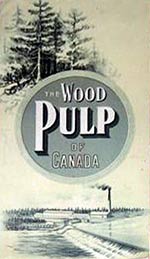| "Canada has a supply of timber which will last for 100 years yet," said M.C. Swanson, superintendent of the Ontario forestry exhibit at the Pan-American, "but the Dominion authorities recognize that something must be done to prevent the total decimation of its timber resources and are experimenting with different plans to re-timber tracts of land which have already been cut over. "Here," said Mr. Swanson, calling attention to a section of log about eight inches through, " is a piece of pine of a variety which it is claimed can be grown to commercial size in ten years. It is not the quality of the red pine or the white pine which we are now cutting and which has been hundreds of years attaining its growth, but it is pine and it will serve to quickly re-forest any cut-over tract." Were Nineteen Rings The rings in the cross section did not indicate that the claims made for it by its advocates could be entirely substantiated, for an eight-inch log is not of commercial size and there were nineteen rings in it, indicating that it had been nineteen years growing to its present size. However, as indicated by the rings, that is about one-tenth the time required by a red pine log to grow to equal size. "Canada has another more practical plan now in use," continued Mr. Swanson, "which prevents the speedy destruction of its pine forests, although it does nothing to renew them. All pine lands in the Dominion are held by the Government, which sells off only a few square miles at a time, just enough to keep the mills running and not enough to encourage a great speculative output. A large part of the mill owners now in Ontario are from the United States. They are the same men who use to raft their logs across the lake to Saginaw, Mich., and cut them there, until action was taken by the Government to stop this practice. They now have their mills in Canada and, while they have to pay import duty on the lumber when it goes into the States, claim they can make as much money as in cutting at Saginaw under the old plan and they save the risk of great loss which was involved in rafting logs across the lake." Ontario Forestry Exhibit
Featured in the exhibit of finished products is a beautiful birch canoe, decorated in burnt work by Mrs. E. Aileen Heming of Hamilton, Ont. On the sides of the bow is lettered the name, Nenemosha, which is the Indian word for sweetheart. The little decking over the bow bears a giant maple leaf, the emblem of Canada. Running along the sides of the canoe are friezes of maple leaves and acorns, joined together in pretty design. At each side of the stern is a leaping dear, while on the stern deck is a life sized picture of an Indian chief. The canoe has been admired by thousands of visitors and scarcely one goes into the exhibit who does not pronounce the decoration a work of genuine art. since the canoe has been exhibited here, it has found a purchaser in the person of a young woman from St. Louis, who gave $500 for it. Six months' time was required in its decoration.
|
 The
exhibit made in the Forestry Building at the Pan-American is made
entirely by the province of Ontario. The Dominion has not exhibited,
for the reason that it is bending all its energies to make a find
exhibit at the great fair in Glasgow, Scotland. This course was taken
for obvious business reasons, as the greater part of Canada's export
timber trade is done with Scotland. Mr. Swanson says it is the present
intention of the Government to make a strong exhibit for the entire
Dominion at the St. Louis World's Fair at St. Louis in 1903. The exhibit
there contsists of both timber in the rough and finished products,
the latter in great variety, while scores of photographs give visitors
a good idea of scenes in the logging woods and camps of Ontario.
The
exhibit made in the Forestry Building at the Pan-American is made
entirely by the province of Ontario. The Dominion has not exhibited,
for the reason that it is bending all its energies to make a find
exhibit at the great fair in Glasgow, Scotland. This course was taken
for obvious business reasons, as the greater part of Canada's export
timber trade is done with Scotland. Mr. Swanson says it is the present
intention of the Government to make a strong exhibit for the entire
Dominion at the St. Louis World's Fair at St. Louis in 1903. The exhibit
there contsists of both timber in the rough and finished products,
the latter in great variety, while scores of photographs give visitors
a good idea of scenes in the logging woods and camps of Ontario.